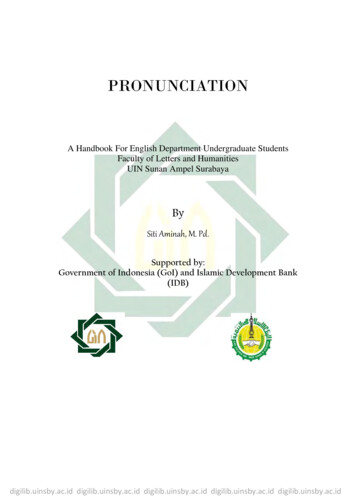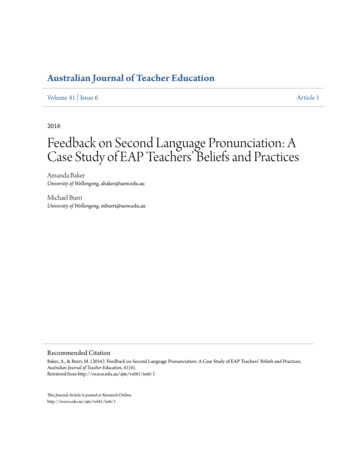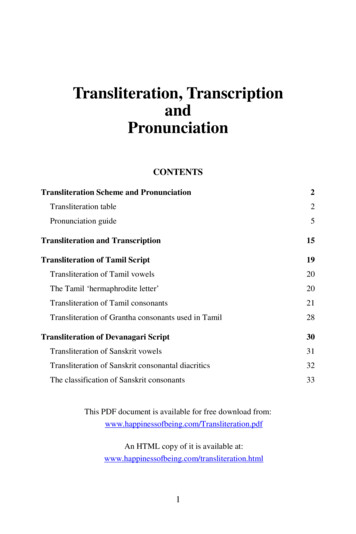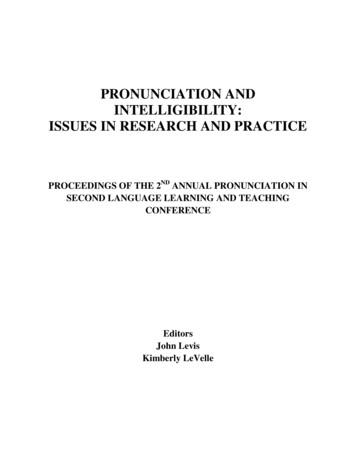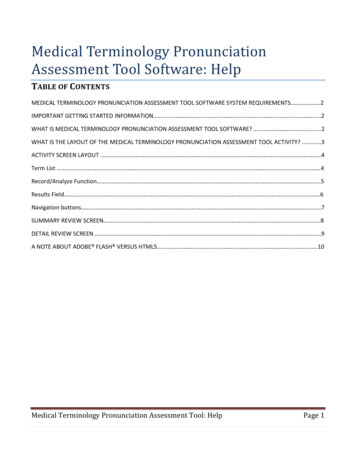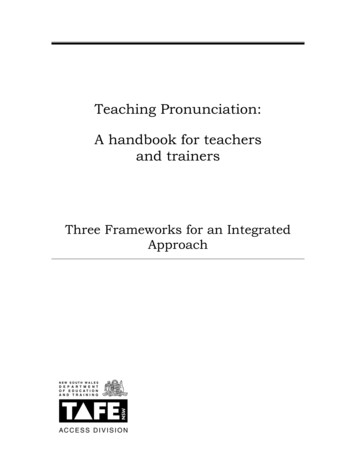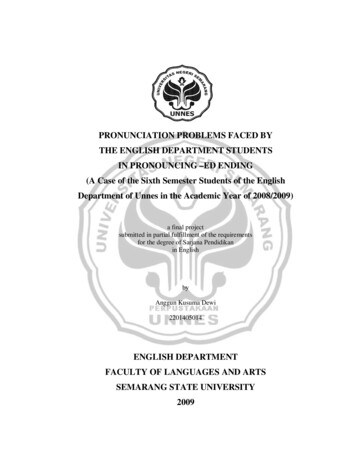
Transcription
PRONUNCIATION PROBLEMS FACED BYTHE ENGLISH DEPARTMENT STUDENTSIN PRONOUNCING –ED ENDING(A Case of the Sixth Semester Students of the EnglishDepartment of Unnes in the Academic Year of 2008/2009)a final projectsubmitted in partial fulfillment of the requirementsfor the degree of Sarjana Pendidikanin EnglishbyAnggun Kusuma Dewi2201405014ENGLISH DEPARTMENTFACULTY OF LANGUAGES AND ARTSSEMARANG STATE UNIVERSITY2009
PERNYATAANDengan ini saya,Nama: Anggun Kusuma DewiNIM: 2201405014Prodi/Jurusan : Pendidikan Bahasa Inggris/ Bahasa dan Sastra Inggris FakultasBahasa dan Seni, Universitas negeri SemarangMenyatakan dengan sesungguhnya bahwa skripsi/ final project yang berjudulPronunciation Problems faced by the English Department Students inPronouncing–ed Ending (A Case of the Sixth Semester Students of the English Department ofUnnes in the Academic Year of 2008/2009) yang saya tulis dalam rangkamemenuhi salah satu syarat untuk memenuhi gelar sarjana ini benar-benarmerupakan karya saya sendiri yang saya hasilkan setelah melakukan analisa,bimbingan, diskusi dan pemaparan/ ujian. Semua kutipan baik yang diperoleh darisumber kepustakaan, media elektronik, maupun sumber-sumber lainnya telahdisertai keterangan mengenai identitas sumbernya dengan cara yang lazim dalampenelitian karya ilmiah. Dengan demikian, walaupun tim penguji dan pembimbingpenulisan skripsi/ final projct ini membubuhkan tanda tangan keabsahannya,seluruh isi skripsi/ final project ini tetap menjadi tanggung jawab saya sendiri.Jika di kemudian hari ditemukan pelanggaran terhadap konvensi penulisan karyailmiah, saya bersedia menerima akibatnya.Demikian, surat pernyataan ini dapat digunakan seperlunya.Semarang,Yang membuat pernyataanAnggun Kusuma Dewi2201405014ii
APPROVALThe final project was approved by the board of examination of the EnglishDepartment of the Faculty of Languages and Arts of Semarang State Universityon September 2009.Board of Examination1. ChairpersonDrs. Dewa Made K., M.Pd1951111819840310012. SecretaryDrs. Ahmad Sofwan, Ph.DNIP 1962042719890110013. First ExaminerDrs. Amir Sisbiyanto, M. Hum.NIP 1954072819830310024. Second Advisor as Second ExaminerDrs. Alim Sukrisno, M.A.NIP 1952062519811110015. First Advisor as Third ExaminerProf. Dr. Warsono, M. A.NIP 194406141970081001Approved byDean of Languages and Arts FacultyProf. Dr. Rustono, M. Hum.NIP.195801271983031003iii
Learn from yesterday, do the best today, plan for a better tomorrow(NN).iv
This final project is dedicated to:my beloved parents, sister, and nephew.v
ACKNOWLEDGEMENTFirst and foremost, I would like to express my deepest gratitude to Allah SWT,the Almighty for the blessing given to me in completing this final project.My greatest attitude goes as well to Prof. Dr. Warsono, M.A, my firstadvisor, for giving guidance and suggestion during the completion of this finalproject. I also would like to express my greatest appreciation to Drs. AlimSukrisno, M. A., my second advisor, for his willingness to guide and correct myfinal project thoroughly.My gratitude is also dedicated to the board of examiners, especially thefirst examiner, Drs. Amir Sisbiyanto. M. Hum. for his valuable suggestions andcorrections.My special honor goes to the head of the English Department of SemarangState University and all lecturers who have taught as well as motivated and guidedme since the first year of my study.Finally, I would like to thank my beloved parents, sister, nephew, and allmy friends (especially Gita, Feny, Yaya, and Susan) for their continuous prayersand motivation.Hopefully, this final project will be useful for all the readers.Semarang,Anggun Kusuma Dewi220140501vi
ABSTRACTKusuma Dewi, A. 2009. Pronunciation problems faced by the EnglishDepartment Students in Pronouncing –ed ending (A Case of the SixthSemester Students of the English Department of Unnes in theAcademic Year of 2008/2009). Final Project. English Department,Faculty of Languages and Arts, Semarang State University. Firstadvisor: Prof. Dr. Warsono, M.A. Second advisor: Drs. AlimSukrisno, M.A.This final project is about the problems faced by the English Department studentsof Unnes in pronouncing –ed ending (a case of the sixth semester students of theEnglish Department of Unnes in the academic year of 2008/2009). The objectivesof this study is to show the level of students’ mastery in pronouncing –ed endingas well as to explain common difficulties faced by the students in pronouncing –ed ending.The population of this research was the sixth semester students ofeducation program of the English Department of Unnes in the academic year2008-2009. In this research I used purposive random sampling as the samplingtechnique. Twenty five (25) students or about 11% were chosen as the samplesout of 226 students. They were given 40 test items containing words with –edending to be pronounced.The result of the investigation shows that the students ‘ability inpronouncing –ed ending is still poor. Based on the analysis, the most difficult typeof –ed ending faced by the students was –ed ending with special pronunciation (ed ending which do not follow the rule). Only 26.5% of them were able topronounce it correctly. They failed in pronouncing –ed ending with specialpronunciation. Meanwhile, the easiest one for them was –ed ending after [d] and[t]. Ninety five percent (95%) of the students were excellent in pronouncing it.The problems faced by the students in pronouncing –ed ending may becaused by their lack of knowledge of the pronunciation of –ed ending. It is alsopossible that they know the theory well, but they are not able to pronounce itproperly.Based on the result obtained, I suggest that the English teachers shouldgive more drills and practice to the students in pronouncing –ed ending. For thestudents, they should learn and practice the pronunciation of –ed ending more.vii
TABLE OF CONTENTSACKNOWLEDGEMENT viABSTRACT viiTABLE OF CONTENTS viiiLIST OF APPENDICES . xiLIST OF PICTURE xiiLIST OF TABLES xiiiLIST OF DIAGRAM . xivCHAPTER1. INTRODUCTION1.1 Background of the Study 11.2 Reasons for Choosing the Topic 21.3 Statements of the Problem 21.4 Objectives of the Study 31.5 Significances of the Study 31.6 Limitation of the Study 31.7 Organization the Study 42. REVIEW OF RELATED LITERATURE2.1 Classification of English Sounds . 52.1.1 Consonants 72.1.2 English Vowels 82.1.3 Diphthong 9viii
2.2 Pronunciation 92.3 Problems of English Pronunciation 112.4 –ed ending in the Past Participle 132.5 The Difference between –ed Ending and –ing Ending in Adjectives 142.6 Pronunciation of –ed Ending 153. METHODS OF INVESTIGATION3.1 Main Source of the Data 163.2 Subjects of the Study . 163.2.1 Population . 163.2.2 Sample . 173.3 Instrument of Collecting the Data 173.4 Method of Collecting the Data . 203.5 Method of Analyzing the Data 214. DATA ANALYSIS AND INTERPRETATION4.1 Analysis of the Data 234.2 Result of the Data Analysis . 244.3 Calculation of the Score . 344.4 Interpretation of the Data 375. CONCLUSIONS AND SUGGESTIONS 39BIBLIOGRAPHY . 41APPENDICES . 43ix
LIST OF APPENDICESAppendix 1The Instrument 43Appendix 2The List of the Respondents 45Appendix 3The Phonetic Transcription of the Items . 46Appendix 4Item Number Analysis 47Appendix 5The Students’ Pronunciation 48x
LIST OF PICTUREPicture Page2.1 Vocal Tract 6xi
LIST OF TABLESTable Page2.1Chart of English Consonants 72.2Classification of English Consonants 82.3Mastery Level Used in the Curriculum of 2004 222.4The Summary of the Analysis 332.5Respondents’ Score 34xii
LIST OF DIAGRAMDiagram Page2.1Features of Pronunciation xiii10
CHAPTER IINTRODUCTIONThis chapter consists of background of the study, reasons for choosing the topic,statements of the problem, objectives of the study, significances of the study,limitation of the study, and organization of the study.1.1 Background of the StudyOne of the requirements that must be completed for the degree of Sarjana is a finalproject. Students of some universities especially Unnes, are required to conduct aresearch which is related to their majors. Majoring English in the EnglishDepartment of Unnes, I am interested in conducting a research about pronunciation.Pronunciation plays an important role in learning English. In order to beunderstandable, people should deliver their speech with proper Englishpronunciation. Learning pronunciation is quite difficult for Indonesian students sincethey have been used to speaking their mother tongue since childhood. Moreover,English is greatly different from Indonesian language in its pronunciation system.The common problem of learning English pronunciation is caused by the differencesbetween the sound systems of the two languages. There are some sounds in Englishwhich do not exist in Indonesian. The vowels, such as [æ], [I:], [u:] and consonants,such as [ð], [θ], [ʒ], do not exist in Indonesian. It will be difficult for Indonesianstudents to pronounce them.English also has consonant clusters, consisting of initial cluster, like [fl] in“fly” and final clusters, like [pt] in stopped. Final clusters are considered more1
2difficult than initial clusters. The Indonesian language may have some initial clusters,like [pr] in “pramuka”, but it does not have final clusters as English has.Many learners even English Department students of Unnes often face somedifficulties in pronouncing final clusters, especially those with –ed ending. It is basedon my experience being a student in the English Department of Unnes. Theoretically,the students may know the rules of pronouncing –ed ending properly, but they seemto find it difficult to pronounce it orally.From the description above, I would like to conduct a research on theproblems faced by the English Department students of Unnes in pronouncing –edending. I would like to find out how well the students master the pronunciation of –ed ending and what problems they face in pronouncing it.1.2 Reasons for Choosing the TopicI choose the topic for the following reasons:1.Students in the sixth semester are expected to be able to pronounce Englishwords including –ed ending correctly since they have got phonology subject,2.According to my experience, students tend to know how to pronounce wordsincluding –ed ending theoretically, but they are not able to pronounce it orally,and3.Pronunciation plays an important role in learning a second language.1.3 Statements of the ProblemIn this study, I would like to answer the following problems:1.how well do the sixth semester students of English Department of Unnes masterthe pronunciation of –ed ending?, and
32.what problems are faced by the sixth semester students of English Department ofUnnes in pronouncing –ed ending?1.3 Objectives of the StudyThe objectives of the research are:1.to show the level of the students’ mastery in pronouncing –ed ending, and2.to explain common difficulties faced by the students in pronouncing –ed ending.1.4 Significances of the StudyThe significances of the study are:1.teachers are able to know the problems faced by the students in pronouncing –edending, so they can prepare the teaching materials well, and2.students can improve and optimize their mastery of pronunciation including –edending.1.5 Limitation of the StudyIn order not to make misunderstanding, I would like to limit the study as follows:1.the subjects of the study are limited to the sixth semester students of EnglishDepartment of Unnes, and2.the study is limited to English words that end with –ed ending.1.6 Organization of the Study
4This paper consists of the following five chapters:Chapter I is introduction which consists of Background of the Study, Reasonfor Choosing the Topic, Statements of the Problem, Significances of the Study, andLimitation of the Study.Chapter II is review of related literature. It consists of Classification ofEnglish Sounds, Pronunciation, Problem of English Pronunciation, -ed Ending in thePast Participle, The Difference between –ed Ending and –ing Ending in Adjectives,and Pronunciation of –ed Ending.Chapter III is methods of investigation which consists of Main Source of theData, Subjects of the Study, Instrument for Collecting the Data, and Method ofAnalyzing the Data.Chapter IV is Data Analysis and Interpretation.Chapters V is Conclusions and Suggestions.
CHAPTER IIREVIEW OF RELATED LITERATUREIn order to support my idea, large amount of information and ideas are absolutelyneeded in carrying out this study. That is why, I used many reference textbooks thatare related to the subject matter and other resources, such as materials from internetand the reports of previous studies and researches on similar topic. This chapter willpresent the review. It consists of the following seven main discussions.2.1 Classification of English SoundsThe speech sounds we produce are actually air movements. As stated by Syafei(1988:4) that “English speech sounds are all produced by air which comes from thelungs into the throat and then passes through the mouth and/or the nose.” In this case,speech organs play an important role to produce sounds.Sari (1988:105) uses the term “vocal tract” to represent speech organs. Shepoints out that vocal tract is important for two reasons. First, it is impossible forhuman being to deliver speech without vocal tract. Second, and more importantly,she says “terms which refer to physical properties of the vocal tract are used todescribe the physiological units of phonology.” The following is the picture of vocaltract according to Sari.5
6Picture 2.1. Vocal tractSource: Sari alveolar ridge, the bony ridge right behind the upper teethpalate, the bony dome constituting the roof of the mouthvelum, the soft tissue immediately behind the palateuvula, the soft appendage hanging of the velumpharynx, the back wall of the throat behind the tongueepiglottis, the soft tissue which covers the vocal cords during eating, thusprotecting the passage-way to the lungs(10) esophagus, the tube going to the stomach(11) larynx, containing the vocal cords(12) trachea, the tube going to the lungs(Sari, 1988:106)Sahulata (1988:29) classifies English sounds into three categories. They areconsonants, vowels, and diphthong.
72.1.1 ConsonantsEnglish has 24 consonants. They are [p], [b], [t], [d], [k], [g], [f], [v], [θ], [ð], [s], [z],[ʃ], [ʒ], [h], [t], [tʃ], [dʒ], [m], [n], [ŋ], [l], [r], [w] (Ramelan, 1999:12).Further, Ramelan (2003:100) classifies consonants into three types asfollows:a. Based on the place where the optimum obstruction takes place: bilabialconsonants, labio-dental consonants, apico-dental or just dental consonants,alveolar consonants, palatal, velar, and glottal.b. Based on the way in which the air is obstructed by the articulators: plosive orstop consonants, affricate consonants, fricative consonants, nasal consonants,lateral consonants, rolled consonants, and semi-vowel or glide consonants.c. Based on the activity of the vocal cords: voiced and voiceless consonants.In classifying consonants, some linguists have different opinions, but more orless they are the same.Source: Ramelan 2003:108
8Table 2. 2 Classification of English ConsonantsSource: Jackson 1982:192.1.2 English VowelsEnglish has 12 (twelve) pure vowels. They are [i:], [I], [ε], [æ], [a:], [ɔ], [ɔ:], [U],[u:], [Λ], [ə], [ə:] (Ramelan, 1999:57). Jackson (1980: 20) classifies vowels into threekinds: front vowels, central vowels, and back vowels.a. Front vowelEnglish has four vowels in the front area; all are made with spread lips. Theyare close front spread vowel [i:], lowered and centralized close front spreadvowel [I], mid front spread vowel [ε], and open front spread vowel [æ].b. Back vowelsThere are five vowels in the back area of the mouth. They are close backrounded vowel [u:], lowered and centralized close back rounded vowel [U],
9mid back rounded vowel [ɔ:], open back rounded vowel [ɔ], and open backspread vowel [a:].c. Central vowelsThere are three vowels produced in the central area of the mouth. They areopen central spread vowel [Λ], mid central spread vowels [ə:] [ə], and schwavowel in unstressed syllable.2.1.3 DiphthongAccording to Ramelan (1999:81) diphthong is “a kind of vowel sound with a specialfeature; that is there is a deliberate glide made from one vowel position to anothervowel position, and which is produced in one syllable.” Further, Ramelan classifiesdiphthong into two categories: “closing and centering diphthongs.”Closing diphthong occurs when the movement of the tongue is carried outfrom the position of open vowel to that of a closer vowel. There are fiveclosing diphthongs in English. They are [εI], [ɔU], [aI], [aU], and [ɔI].Meanwhile, when the movement of the tongue is carried out towards thecentral vowel [ə], the diphthong is called a centering diphthong. There arefour centering diphthongs; [Iə], [Uə], [ɔə], and [εə] (Ramelan, 1999).2.2 PronunciationPronunciation plays an important role in delivering speech. In order to beunderstandable, we should deliver our speech with correct pronunciation. In general,pronunciation is the way in which a language is spoken. Dalton and Seidlhofer(2001:3) define pronunciation in general term as the production of significantsounds. According to them, sound is significant in two senses.
10First, sound is significant because it is used as part of a code of a particularlanguage. So we can talk about the distinctive sounds of English, French,Thai, and other languages. In this sense we can talk about pronunciation asthe production and reception of sounds of speech. Second, sound issignificant because it is used to achieve meaning in contexts of use. Here thecode combines with other factors to make communication possible. In thissense we can talk about pronunciation with reference to acts of speaking.According to Syafei (1988:1), pronunciation is a two fold process. He argues“it involves the recognition of sounds as well as the production of sounds.” He addsthat “a student is faced with the problem of recognizing and discriminating thesounds as well as the problem of producing the sounds.”Pronunciation can be broken down into its constituent parts (Kelly, 2006:1).The following diagram shows a breakdown of the main features of pronunciation.Diagram 2.1Features of PronunciationSuprasegmental essunvoicedWord stressSingle vowelsshortdiphthongslongSource: Kelly 2006:1Sentence stress
11Phonemes are units of sound which can be analyzed. It is also known assegments. On the other hand, suprasegmental features are features of speechwhich are generally applied to groups of segments, or phonemes. In English,intonation and stress are the important features of suprasegmentals (Kelly,2006:3).According to Ramelan (2003:22), “when a speaker produces an utterance, itcan be distinguished into segmental and suprasegmental features.” He states that“segmental features, or just segmentals refer to sound units arranged in a sequentialorder.” He gave the example, when we say “good heavens”. It has nine segmentalfeatures; /gud-hεvənz/. Meanwhile, Ramelan also explains that “suprasegmentalfeatures, or just suprasegmentals refer to such features as stress, pitch, intonation,and other features that always accompany the production of segmental.”2.3 Problem of English PronunciationAs stated in the previous chapter Indonesian learners often face some difficulties inlearning English, especially in its pronunciation system. When a baby starts to talk,he does it by listening to the sound of his mother and he will automatically imitatehis mother. He has been used to speaking his mother tongue since childhood. Thismother tongue, according to Ramelan (1999:4) “has been deeply implanted in him aspart of his habits.” Moreover he says that “it will be difficult for him to change thehabit of moving his speech organs in such a way as to produce the foreign sounds.” Itis understandable since the movements of his speech organs have been set to producethe speech sounds of his own language.Kelly (2006:4) says that “we all use the samespeech organs to produce the sounds we become accustomed to producing.” He adds
12that “the set of sounds we acquire, however, may vary: a child brought up in anEnglish-speaking environment will develop the phonemes of English, a Frenchspeaking child will develop a different set, and so on.” In other words, anIndonesian-speaking child, of course will develop the phonemes of Indonesian whichare difficult for him to change.Syafei (1988:1) explains the reasons why English is difficult for Indonesianlearners as follows.English is quite difficult for Indonesian learners because of two cases. First,the difficulties are because of the irregular spelling of English. It offers poorguidance to its pronunciation. Second, the difficulties are due to interference(negative transfer) from Indonesian to the target language (English).Moreover, Syafei (1998:1) argues “the learners’ effort to learn the newlanguage will meet with strong opposition from his old established habits.” This iscalled “habit interference” (Ramelen, 1999:5). Meanwhile, Odlin (1993:2) called it“cross-linguistic influence” or “language transfer”. He defines transfer as “theinfluence resulting from similarities and differences between the target language andany other language that has been previously (and perhaps imperfectly) acquired.”Ramelan (1999:5) says that “the difficulty encountered by the student inlearning a second language is caused by the different elements found between hislanguage and the target language.” Further he says that “the degree of difficulty inlearning is also determined by the degree of difference between the two languages.”The greater the similarity between them, the less difficult it will be for the student tolearn the foreign language. This opinion is more or less the same as that of Lado (inOdlin, 1993:15) which reads as follows.We assume that the student who comes in contact with a foreign languagewill find some features of it quite easy and others extremely difficult. Thoseelements that are similar to his native language will be simple for him, andthose elements that are different will be difficult. The teacher who has made a
13comparison of the foreign language with the native language of the studentswill know better what the real learning problems are and better provide forteaching them.Moreover, Ramelan (1999:7) points out the nature of pronunciation problemsin learning a foreign language as follows.Firstly, the problem is concerned with the identification of the foreign sounds.Learners have to remember their acoustic qualities so that they will be able todirectly identify them in an utterance. Secondly, the problem is concernedwith the production of sounds by their speech organs. They should be able tohear and identify the acoustic quality of the foreign sounds in order to be ableto produce them. The last problem is concerned with the production ofsuprasegmental features like stress, length, pitch, and intonation.2.4 –ed Ending in the Past ParticipleAccording to http://www.bukisa.com/articles/25262 identify-the-tenses-and-partsof-verbs, all verbs have four principal parts. Those parts are the base form, the pastform, the present participle, and the past participle. The past form of verbs includesregular verbs and irregular verbs. We can find –ed ending in the past form of regularverbs and past participle.“A past participle indicates past or completed action or time. It is often calledthe “ed” form as it is formed by adding “d” or “ed” to the base form of regular verbs,but it is also formed in various other ways for irregular plepast.htm)We use the past participle in the following ways:a. With the perfect tensesI’ve stayed at the hotel several times.Jim hadn’t earned enough money to buy a car yet.b. With the passive voicedThe store was closed by the time we got there.Electrical charge is carried by subatomic particles.
14c. Participial phrasesBased on the result of the tests, we changed our plan.Irritated by the inefficiency, the boss yelled at the workers.d. Participial adjectivesI was pleased to see her again.The bored students sat quietly through tpart.html)lecture.2.5 The Difference between –ed ending and –ing ending in AdjectivesWe do not only find –ed ending in the past form of regular verbs and past participle,but also in adjectives. There is a large group of adjectives which can have an –ed or –ing ending. However, there is a significant difference between them. According toRedman (2001:64), “the –ing ending is used on adjectives which describe a person orthing or situation. Meanwhile, the –ed ending is used on adjectives which describethe effect this person, thing, or situation has on us.” The example of words thelinguists usually use to differentiate those two endings are boring and bored.To differentiate between ‘boring and ‘bored’, Murphy (2007:1) in his bookgives the example of situation as follows.“Jane has been doing the same job for a very long time. Everyday she doesexactly the same thing again and again. She doesn’t enjoy it anymore andwould like to do something different.”From the description above, we can say:Jane’s job is boring.Jane is bored (with her job).In conclusion, somebody is bored if something (or somebody else) is boring.In other words, if something is boring, it makes you bored, so:Jane is bored because her job is boring.Jane’s job is boring, so Jane is bored. (not “Jane is boring”)
152.6 Pronunciation of –ed EndingThere is a large number of words in English that end with –ed as stated in theprevious discussion. We can find words with –ed ending in the past forms and pastparticiple forms. Syafei (1988:90) says that the –ed ending is used to make the pasttense and the past participle. He adds that it has three pronunciation; [t] as in“picked”[pIkt], [d] as in ‘believed” [bIli:vd], and [Id] as in “needed” [ni:dId].Moreover, he indicates the rules to pronounce the –ed ending as follows:a. [d] after all voiced consonants except [d], and after all vowel sounds as inplanned [plænd], begged [begd], played [pleid].b. [t] after all voiceless consonants except [t] as in stopped [stopt], kissed [kIst],picked [pIkt]c. [id] after [d,t] as in needed [ni:dId], wanted [wɔntId]While Syafei is focusing on the pronunciation of –ed ending as the past tense andpast participle forms, Bowler and Cunningham (2004:29) focus on –ed ending asadjective only. Just like when it occurs in past forms and past participle, -ed endingin adjective also has the three pronunciations: [t], [d], and [Id]. As that of Syafei’s,the rules proposed by Bowler and Cunningham in pronouncing –ed ending is more orless the same. The rules are as follows:a. When –ed follows the sound [d] or [t], it is pronounced [Id]b. When –ed follows a voiceless consonant apart from [t] ([p], [k], [f], [s], [θ],[ ], [t ], it is pronounced [t])c. When –ed follows a vowel sound, or a voiced consonant sound apart from [d]([b], [g], [v], [z], [ð], [ʒ], [dʒ], [m], [n], [ŋ], [l], [r], it is pronounced [d])However, Bowler and Cunningham state that there are some adjectives which donot follow these rules. They have –ed endings which are pronounced [Id], such as innaked [‘neikId], wicked [‘wikId], etc.
CHAPTER IIIMETHODS OF INVESTIGATIONThis chapter presents main sources of the data, subject of the study includingpopulation and sample, instrument for collecting the data, method of collecting thedata, and method of analyzing the data.3.1 Main Source of the DataSome data were needed to find out the solution to the problems posed in the previouschapter. The data were the pronunciations of –ed ending sounds. It was obtainedfrom the population, i.e. the sixth semester students of education program of Englishdepartment of Unnes.3.2 Subjects of the StudyThe subjects of the research were the sixth semester students of English Departmentof Unnes in the academic year of 2008/2009. The subjects were categorized intopopulation and sample.3.2.1 PopulationPopulation plays an important role in conducting this research. Best (1981: 8) states“population is any group of individuals that have one or more characteristics incommon that interest the researcher.” We can conclude that population is the whole16
17members of particular group that interest the researcher to get some information inconducting a research.The population of this study was the sixth semester students of educationprogram of English department of Unnes. After being subtracted by inactivestudents, the total population was 226 students. It includes 92 students of regularclasses and 134 students of pararel classes.3.2.2 SampleAccording to Arikunto (1998:117), sample is part of population. To facilitate theresearcher in gathering the data, sampling is needed. Due to the ‘rombel’ systemapplied in every subject, to make me easier in taking the sample, I used purposiverandom sampling as the sampling tec
pronunciation. Learning pronunciation is quite difficult for Indonesian students since they have been used to speaking their mother tongue since childhood. Moreover, English is greatly different from Indonesian language in its pronunciation system. The common problem of learning English pronunciation is caused by the differences

